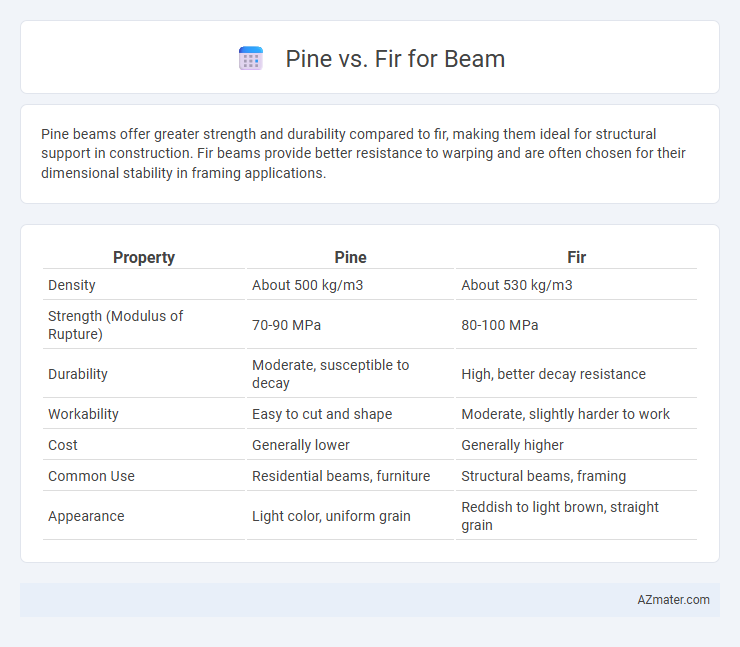Pine beams offer greater strength and durability compared to fir, making them ideal for structural support in construction. Fir beams provide better resistance to warping and are often chosen for their dimensional stability in framing applications.
Table of Comparison
| Property | Pine | Fir |
|---|---|---|
| Density | About 500 kg/m3 | About 530 kg/m3 |
| Strength (Modulus of Rupture) | 70-90 MPa | 80-100 MPa |
| Durability | Moderate, susceptible to decay | High, better decay resistance |
| Workability | Easy to cut and shape | Moderate, slightly harder to work |
| Cost | Generally lower | Generally higher |
| Common Use | Residential beams, furniture | Structural beams, framing |
| Appearance | Light color, uniform grain | Reddish to light brown, straight grain |
Introduction to Pine and Fir as Beam Materials
Pine wood, known for its light weight and moderate strength, is widely used in construction for beams due to its good workability and availability. Fir, especially Douglas fir, offers superior strength and stiffness compared to pine, making it suitable for load-bearing beams in structural applications. Both woods are favored in framing and beam construction, but fir's higher density and durability often make it the preferred choice for heavy-duty support.
Key Physical Properties: Pine vs Fir
Pine beams are generally lighter and softer, offering easier workability but lower resistance to bending and compression compared to fir. Fir beams exhibit higher strength, greater stiffness, and better dimensional stability, making them ideal for structural applications requiring durability and load-bearing capacity. Both woods have moderate resistance to decay, but fir typically performs better in long-term structural uses due to its tighter grain and denser growth.
Strength and Durability Comparisons
Pine beams exhibit moderate strength with a Janka hardness rating around 420, making them suitable for light to medium structural applications, while fir beams often provide higher strength, with Douglas fir reaching a Janka hardness of approximately 660. Fir generally offers better durability and resistance to warping and splitting compared to pine, contributing to longer-lasting structural integrity in beams under varying environmental conditions. Both species require proper treatment for enhanced longevity, but fir's superior load-bearing capacity and dimensional stability make it a preferred choice for heavy-duty construction projects.
Weight and Workability Differences
Pine beams are generally lighter than fir beams, making them easier to handle and transport on construction sites. Fir is denser and heavier, which provides greater strength and durability but requires more effort during cutting and installation. The workability of pine is higher due to its softer texture, while fir demands sharper tools and more precision to achieve clean finishes.
Resistance to Decay and Insects
Fir beams exhibit superior resistance to decay and insects compared to Pine, largely due to their tighter grain structure and natural extractives that deter pests. Pine is more susceptible to fungal decay and insect infestation unless treated with preservatives, making Fir a preferred choice for structural applications in humid or pest-prone environments. The enhanced durability of Fir beams contributes to longer lifespan and reduced maintenance costs in construction projects.
Cost Efficiency: Pine vs Fir for Beams
Pine beams offer greater cost efficiency due to their faster growth rates and widespread availability, resulting in lower prices compared to fir beams. Fir beams provide superior strength and durability but come at a higher cost, making them suitable for projects where structural integrity outweighs budget constraints. Choosing pine for beams balances affordability with adequate performance for many residential and light commercial applications.
Aesthetic Considerations and Grain Patterns
Pine beams are prized for their warm, golden hues and distinctive knots that create a rustic, inviting ambiance, while fir beams feature a more uniform, reddish-brown tone with subtle, straight grain patterns that offer a sleek and modern appearance. The coarse, pronounced grain in pine highlights natural character and texture, making it ideal for traditional or country-style interiors. Fir's tight, consistent grain provides smooth surfaces that complement contemporary architectural designs with clean lines and minimalistic aesthetics.
Sustainability and Environmental Impact
Pine beams offer high sustainability due to their fast growth rate and widespread availability, making them a renewable resource with lower environmental impact. Fir beams also contribute positively to sustainability, as fir trees absorb significant amounts of CO2 during their growth, aiding carbon sequestration. Both woods are biodegradable and can be sourced from responsibly managed forests, minimizing habitat disruption and promoting ecological balance.
Typical Applications in Construction
Pine beams are commonly used in residential framing and roof trusses due to their strength-to-weight ratio and ease of treatment for pest resistance. Fir beams excel in heavy timber construction and large-scale structural applications where high load-bearing capacity and dimensional stability are required. Both woods are favored for their workability and availability but fir is preferred for commercial projects demanding greater durability and structural integrity.
Choosing the Right Wood: Pine or Fir for Your Beam Project
Selecting the right wood for beam construction hinges on strength, durability, and appearance, where fir offers superior structural integrity due to its higher density and straight grain, making it ideal for load-bearing applications. Pine beams provide a cost-effective option with good workability and a warm, natural look but are generally softer and more prone to dents and wear. Considering environmental conditions and load requirements ensures the chosen species meets both functional and aesthetic needs in your beam project.

Infographic: Pine vs Fir for Beam
 azmater.com
azmater.com